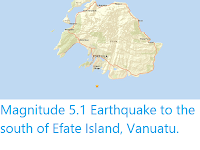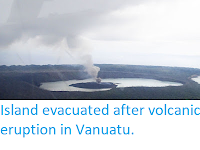Six people have been confirmed dead and 21 more are missing after Cyclone Harold made landfall on the Espiritu Santo, the largest island of the Republic of Vanuatu, on Monday 6 April 2020. The storm is described as a Catagory 5 Cyclone, which brought with it sustained wind speeds of up to 235 km per hour (a sustained wind speed is a speed that is sustained for over a minute), making it the most severe storm ever to hit Espiritu Santo, and the worst storm to hit Vanuatu in five years. After passing over Espiritu Santo the island gained strength as it moved to the southeast, hitting the island of Pentacost with sustained winds of 270 km per hour later in the day.
Damage caused by Cyclone Harold on the island of Espiritu Santo, Vanuatu. Oscar Delai Umuumulovo/IRFCAsiaPacific/Twitter.
Tropical
storms, called Cyclones in the Indian Ocean and South Pacific, are caused by solar energy heating the air above the oceans,
which causes the air to rise leading to an inrush of air. If this
happens over a large enough area the inrushing air will start to
circulate, as the rotation of the Earth causes the winds closer to the
equator to move eastwards compared to those further away (the Coriolis
Effect). This leads to tropical storms rotating clockwise in the
southern hemisphere and anticlockwise in the northern hemisphere. These
storms tend to grow in strength as they move across the ocean and lose
it as they pass over land (this is not completely true: many tropical
storms peter out without reaching land due to wider atmospheric
patterns), since the land tends to absorb solar energy while the sea
reflects it.
The path and strength of Cyclone Harold. Thick line indicates the
past path of the storm (till 6.00 am GMT on Tuesday 7 April 2020), while the thin line indicates the predicted future path of the storm,
and the dotted circles the margin of error at twelve and twenty four, thirty six, forty eight, and seventy two hours ahead. Colour indicated the severity of the storm. Tropical Storm Risk.
Despite the obvious danger of winds of this speed, which can physically
blow people, and other large objects, away as well as damaging buildings
and uprooting trees, the real danger from these storms comes from the
flooding they bring. Each drop millibar drop in air-pressure leads to an
approximate 1 cm rise in sea level, with big tropical storms capable of
causing a storm surge of several meters. This is always accompanied by
heavy rainfall, since warm air over the ocean leads to evaporation of
sea water, which is then carried with the storm. These combined often
lead to catastrophic flooding in areas hit by tropical storms.
Flooding associated with Cylcne Harold on Espiritu Santu Island. Oscar Delai Umuumulovo/IRFCAsiaPacific/Twitter.
See also...









